A gelatinous cube is a fictional monster from the Dungeons & Dragons fantasy role-playing game. It is described as a ten-foot cube of transparent gelatinous ooze, which is able to absorb and digest organic matter.
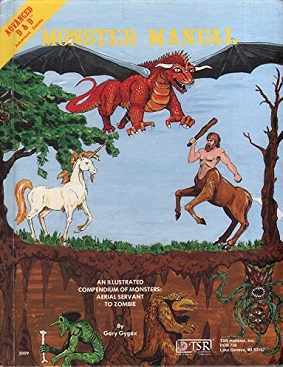
The Monster Manual is the primary bestiary sourcebook for monsters in the Dungeons & Dragons fantasy role-playing game, first published in 1977 by TSR. The Monster Manual was the first hardcover D&D book and includes monsters derived from mythology and folklore, as well as creatures created specifically for D&D. Creature descriptions include game-specific statistics, a brief description of its habits and habitats, and typically an image of the creature. Along with the Player's Handbook and Dungeon Master's Guide, the Monster Manual is one of the three "core rulebooks" in most editions of the D&D game. As such, new editions of the Monster Manual have been released for each edition of D&D. Due to the level of detail and illustration included in the 1977 release, the book was cited as a pivotal example of a new style of wargame books. Future editions would draw on various sources and act as a compendium of published monsters.
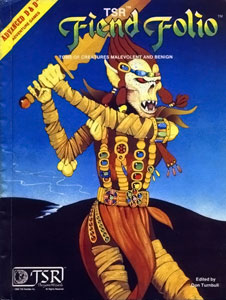
Fiend Folio is the name of three separate products published for successive editions of the fantasy role-playing game Dungeons & Dragons (D&D). All three are collections of monsters.
A displacer beast is a fictional evil feline creature created for the Dungeons & Dragons role-playing game in 1975; it has subsequently been included in every edition of the game to the present day.

Trolls are fictional monsters in the Dungeons & Dragons roleplaying game.
Several different editions of the Dungeons & Dragons (D&D) fantasy role-playing game have been produced since 1974. The current publisher of D&D, Wizards of the Coast, produces new materials only for the most current edition of the game. However, many D&D fans continue to play older versions of the game and some third-party companies continue to publish materials compatible with these older editions.

In the Dungeons & Dragons fantasy role-playing game, the mimic is a type of fictional monster. It is portrayed as being able to change its shape to disguise its body as an inanimate object, commonly a chest. The mimic uses a powerful adhesive that holds fast to creatures that touch it, allowing the mimic to beat its victims with its powerful pseudopods. The mimic was introduced in the first edition Advanced Dungeons & Dragons game's original Monster Manual. The mimic has appeared in subsequent editions. Several variants of the creature have been introduced, with a variety of abilities and sizes.

In the Dungeons & Dragons role-playing game, orcs are a primitive race of savage, bestial, barbaric humanoid.

Kobolds are a fictional race of humanoid creatures featured in the Dungeons & Dragons roleplaying game and other fantasy media. They are often depicted as small reptilian humanoids with long tails, distantly related to dragons.

In the Dungeons & Dragons fantasy role-playing game, goblins are a common and fairly weak race of evil humanoid monsters. Goblins are non-human monsters that low-level player characters often face in combat.

In the Dungeons & Dragons fantasy role-playing game, the centaur is a large monstrous humanoid. Based upon the centaurs of Greek myth, a centaur in the game resembles a human with the lower body of a horse.

In the Dungeons & Dragons fantasy role-playing game, giants are a collection of very large humanoid creatures based on giants of legend, or in third edition, a "creature type".
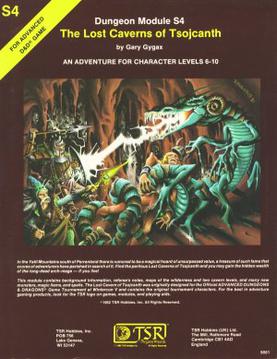
The Lost Caverns of Tsojcanth is an adventure module for the Dungeons & Dragons fantasy role-playing game. It was written by Gary Gygax and published by TSR in 1982 for the first edition Advanced Dungeons & Dragons (AD&D) rules. The 64-page adventure bears the code "S4" and is set in the Greyhawk campaign setting. It is divided into two parts, a 32-page adventure, and a 32-page booklet of monsters and magic items. The plot involves the player characters investigating rumors of lost treasure. After traversing a wilderness and two levels of dungeons, the players face Drelnza, the vampiric daughter of long-deceased archmage Iggwilv.

The lich is an undead creature found in the Dungeons & Dragons (D&D) fantasy role-playing game. Liches are spellcasters who seek to defy death by magical means.
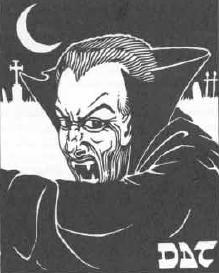
In the Dungeons & Dragons fantasy role-playing game, a vampire is an undead creature. A humanoid or monstrous humanoid creature can become a vampire, and looks as it did in life, with pale skin, haunting red eyes, and a feral cast to its features. A new vampire is created when another vampire drains the life out of a living creature. Its depiction is related to those in the 1930s and 1940s Hollywood Dracula and monster movies. In writing vampires into the game, as with other creatures arising in folklore, the authors had to consider what elements arising in more recent popular culture should be incorporated into their description and characteristics.
Tritons are a fictional species in the Dungeons & Dragons fantasy role-playing game.
In the Dungeons & Dragons fantasy roleplaying game, the intellect devourer is a type of fictional monster.

In the Dungeons & Dragons fantasy role-playing game, the term monster refers to a variety of creatures, some adapted from folklore and legends and others invented specifically for the game. Included are traditional monsters such as dragons, supernatural creatures such as ghosts, and mundane or fantastic animals. A defining feature of the game, is that monsters are typically obstacles that players must overcome to progress through the game. Beginning with the first edition in 1974, a catalog of game monsters (bestiary) was included along with other game manuals, first called Monsters & Treasure and now called the Monster Manual. As an essential part of Dungeons & Dragons, many of its monsters have become iconic and recognizable even outside D&D, becoming influential in video games, fiction, and popular culture.

The gargoyle is a fantasy and horror monster inspired by the gargoyle architectural element. While they were believed in mythology to frighten away evil spirits, the idea of such statues physically coming to life is a more recent notion. Like golems, they are usually made of magically animated or transformed stone, but have animal or chimera traits and are often guardians of a place such as a cathedral or castle. They can also be depicted as vessels for demonic possession or as a living species resembling statues.
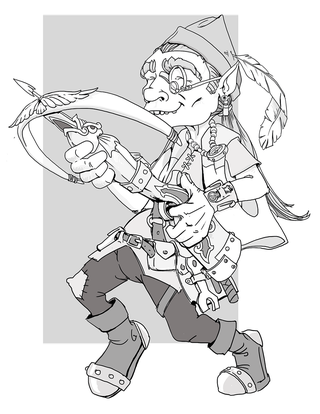
In the Dungeons & Dragons fantasy role-playing game, gnomes are one of the core races available for play as player characters. Some speculate that they are closely related to dwarves; however, gnomes are smaller and more tolerant of other races, nature, and magic. Depending on the setting and subrace, they are often skilled with illusion magic or engineering. Gnomes are small humanoids, standing 3–3.5 feet (91–107 cm) tall.














